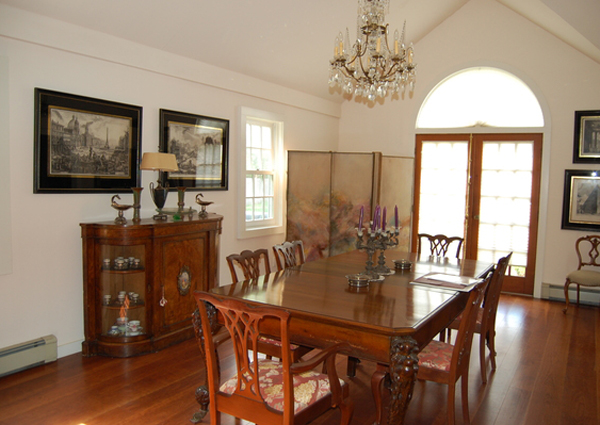
East End gardens are considered to be among the most beautiful in the country. And each year, there are dozens of garden tours on the South Fork alone.
So what is it that makes a Hampton garden so special? Believe it or not, it’s primarily a whole lot less about luxury than it is about sustainability: the most popular plants gracing gardens on the East End this past year were any plants that were considered deer resistant, according to the experts.
Battling the hungry deer is an all too familiar situation for Lydia Wallis, the first vice president of the Southampton Garden Club. She reported that she came back to her home in late August to find that all her planting had been devoured by deer, regardless of a fence that enclosed the property.
According to Christine Martin of The Bayberry nursery and arboretum in Amagansett, this past season, she saw a spike in the number of perennials such as nepeta, Russian sage, lavenders and ferns being sold due to the deer problem. Popular deer-resistant annuals this year included angelonia, snapdragons, plectranthus and helichrysum. However, she added that “tried and true for everyone else are geraniums, impatiens, million bells and Wave petunias in every shade under the sun.”
Charles Marder, co-founder of Marders in Bridgehampton with his wife, Kathleen, said that he advises his clients to use three different strategies to keep deer from devouring their gardens.
“Deer are running wild this year,” said Mr. Marder. “My deer-resistant strategies include companion planting, putting a browse fence around the plants and figuring out garden gates and fences that feel like a garden, not an encampment.”
According to Mr. Marder, companion planting is when a gardener plants deer-resistant plants alongside plants that deer usually eat, keeping the deer-proof plant on the top. This way, deer will not go near the planting at all. He also stressed the use of a browse fence, for when deer browse the plants to see what they will eat, and that gardeners plant deer-resistant plants around the fence. Fences are always important to keeping deer out of any garden, according to Mr. Marder, but choosing a garden gate and fence that fits the tone of the garden can make the enclosure feel more like a garden, rather than a zoo or gated area.
Also central to protecting a garden from deer in the fall as well as year-round, is knowing what kind of plants that deer eat during certain times of the year, according to Mr. Marder. He warned that deer generally eat grasses in the summer due to a metabolism change that shifts with the season. But in the fall, deer often switch to eating conifers and broad-leafed evergreens. These plants include many varieties of yew as well as azaleas.
“After Labor Day, the deer go back to their fall habits,” said Mr. Marder, who stressed that it is vital to protect the plants that are vulnerable at different parts of the year.
According to Mr. Marder, the fall is a time when garden owners should step back and examine their garden to decide what kind of plantings they would like for the coming spring, as well as if they would like to create a fall or winter garden.
For homeowners who are getting their gardens ready for this coming fall, Ms. Wallis recommends that homeowners shy away from the traditional fall colors of red and orange. “I like the pinks, people always associate fall with orange and yellow and golds,” she said. “Dahlias are in bloom in the fall and they’re beautiful. They bloom in yellow, white, pink and salmon. They’re a wonder.”
But Ms. Wallis suggested that those who would like to stick to classic autumn colors go with plantings of black-eyed Susans around their properties.
“They’re biennials and perennials with a black eye,” said Ms. Wallis. “I’ve seen them in the plantings around Southampton village and they really look beautiful.”
For her fall choices, Ms. Martin recommended perennials and shrubs that don’t bloom until late in the season. She suggested lespedeza in white and hot pink, the most popular colors for those who shop at The Bayberry. Other plants that Ms. Martin recommends for early fall are Crape Myrtles that bloom in pinks, corals, white, lavender and fuchsia. She also suggested leonitis, which blooms in bright orange, as well as plectranthus, which blooms in lavender.
But there are Hampton classics when it comes to the garden too. The Bayberry’s popular perennial sellers include magnolias, crape myrtles and flowering cherries.
“In the spring all varieties of rhododendrons and azaleas are popular because that’s when they flower,” said Ms. Martin.
Ms. Wallis however, has her own favorites. “You can’t beat hydrangeas in the Hamptons,” she said.
Mr. Marder also weighed in.
“Hydrangeas are always big sellers, they’re hard to argue against,” he said. “The hydrangea is almost like the signature plant of the Hamptons. It’s really hard to go against that one.”
Looking forward, for gardeners who want to create a winter garden, Mr. Marder suggested that they look at adding color as the season approaches.
“You can build a winter garden that’s really colorful by using slow-growing conifers, such as the dwarf blue spruce,” he said, adding that he highly recommends the gold thread cypress. “The colder it gets, the bolder it gets.”